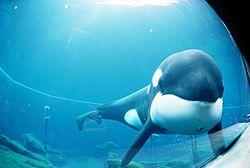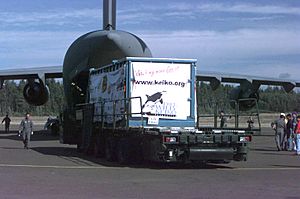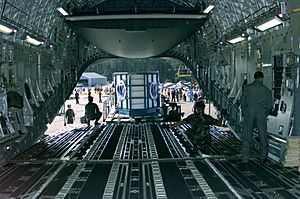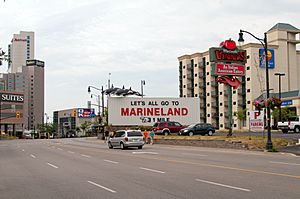Keiko (whale) facts for kids

Keiko on December 1, 1998, at the Oregon Coast Aquarium
|
|
| Species | Orcinus orca |
|---|---|
| Sex | Male |
| Born | September 24, 1976 Near Iceland |
| Died | December 12, 2003 (aged 27) Arasvikfjord, Norway |
| Notable role | Willy in Free Willy |
| Years active | 1979–2003 |
| Weight | 6 tons (12,300 lb; 5440 kg) |
Keiko was a famous male orca (also known as a killer whale). He was born near Iceland on September 24, 1976. Keiko became a worldwide star when he played Willy in the 1993 movie Free Willy.
After the movie, many people wanted Keiko to be set free. He was eventually released into the wild in July 2002 near Iceland. However, he found it hard to live on his own. Keiko died in December 2003 in Norway.
Contents
Keiko's Early Life and Fame
Keiko was caught near Iceland in 1979. He was then sold to an aquarium in Hafnarfjörður, Iceland. Back then, his name was Siggi, and later Kago. In 1982, the orca was sold to Marineland in Niagara Falls, Canada.
In 1985, Keiko was sold again to Reino Aventura. This was an amusement park in Mexico City. There, he was given the name "Keiko". This is a Japanese name that means "lucky one" or "blessed child". Movie scouts found him at the park. He then became the star of the movie Free Willy in 1993.
Efforts to Free Keiko
The movie made Keiko very famous. This led to a big effort to find him a better home. Warner Bros. Studio and Craig McCaw gave money to start the Free Willy-Keiko Foundation in 1995. Many school children also donated money.
The Oregon Coast Aquarium in Newport, Oregon received over $7 million. This money was used to build new facilities for Keiko. The goal was to help him get healthy. Everyone hoped he could eventually return to the wild.
UPS helped move Keiko by land to the nearby Newport Municipal Airport. Before leaving the park in Mexico, Keiko performed for the public one last time. He weighed about 7,700 pounds (3,493 kg).
He was flown in a C-130 Hercules plane donated by UPS. During the flight, Keiko was in a 30-foot-long tank. It was filled with sea water and kept cool with ice cubes.
When Keiko arrived in Oregon in 1996, he moved into a huge new home. It was a concrete pool filled with real seawater. This was his first time living in seawater. By June 1997, Keiko's weight had grown a lot. He weighed 9,620 pounds (4,364 kg).
The idea of returning Keiko to the wild caused a lot of discussion. Some people thought he had been in captivity for too long. They believed he could not adapt to living on his own.
Still, the plan to prepare Keiko for the wild began. On September 9, 1998, he was flown to Klettsvík. This is a bay on the island of Heimaey in Vestmannaeyjar, Iceland. The plane had a problem when it landed. But Keiko was not hurt.
The Free Willy-Keiko Foundation took care of Keiko every day. The Ocean Futures Society also helped manage the project. Keiko first lived in a large pen in Klettsvik Bay. There, he was trained to get ready for his release. This included supervised swims in the open ocean.
The Humane Society of the United States took over managing the project until Keiko's death. Keiko was fully free by the summer of 2002. He left Icelandic waters in early August. He followed some wild killer whales but did not join their group. His journey was tracked using a special tag on his fin.
About a month later, he arrived in Norway's Skålvik Fjord. He seemed to be looking for people and even let children ride on his back. His caretakers moved to Norway. They continued to follow Keiko by boat for the next 15 months. The total cost to free Keiko was about US$20 million.
Keiko's Death
Keiko died in Taknes Bay, Norway, on December 12, 2003. He was swimming in the fjords and was about 27 years old. Doctors believed Pneumonia was the cause of his death.
Many people think the project to free Keiko was not fully successful. This is because he never truly adapted to life in the wild. He never joined a wild group of orcas. He also still needed contact with humans. His return to people for food and company showed that he could not live completely on his own.
Some reasons why Keiko struggled to adapt include:
- He was caught at a young age.
- He spent many years in captivity.
- He had been away from other orcas for a long time.
- He had very strong bonds with humans.
Keiko's Movies and TV Shows
- Quinceañera (1987 TV series)...Orca
- Keiko en peligro (1990)...Keiko
- Free Willy (1993)...Willy
- Free Willy 2: The Adventure Home (1995)... Willy (An animatronic whale was used for most scenes)
- Azul (1996 TV series)... Keiko
- Free Willy 3 (1997)... Willy (An animatronic whale was used for all scenes)
- Keiko: The Untold Story (2010)
See also
 In Spanish: Keiko (orca) para niños
In Spanish: Keiko (orca) para niños





